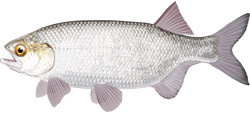
The Fish Sustainability Index (FSI) combines scientific and local knowledge to assess the status of Goldeye (Hiodon alosoides) in Alberta.
Goldeye FSI Maps
Adult Density (Current and Historic)
- Current Adult Density Fish Sustainability (FSI) Rankings for Goldeye
- Historic Adult Density Fish Sustainability (FSI) Rankings for Goldeye
Stocked lake populations are denoted with a circle. Please note that data reliability is not currently displayed in these figures.
Habitat and Overharvest Protection Needs
- Habitat Protection Needs Fish Sustainability (FSI) Rankings for Goldeye, 2014
- Overharvest Protection Needs Fish Sustainability (FSI) Rankings for Goldeye, 2014
Please note that data reliability is not currently displayed in these figures.
The complete FSI spatial data layers can be viewed and downloaded in:
Please note that the Goldeye FSI assessment will be displayed in FWMIT at a watershed-scale, but Goldeye are primarily a mainstem river species.
Goldeye Population Status
In summary, Goldeye in Alberta were found to be generally declining, with degraded water quality and flow alterations in rivers appearing to be the main causes. Targeted inventory and monitoring of Goldeye has not been consistent and conclusions are considered to have moderate to high uncertainty.
Historically, Goldeye were abundant in the large rivers of Alberta, with large runs of migratory fish noted in:
- the Peace-Athabasca delta area
- the North Saskatchewan and Red Deer rivers
Overall, abundance has declined with most populations now at low to moderate abundance. The Battle River population has been nearly lost. Healthy populations appear to be found only in the mainstem Peace River.
Threats to Sustainability
The main threats to sustainability of Goldeye appear to be:
- Poor water quality in the Battle River, especially low oxygen levels associated with nutrients and run-off from intensive land use, is likely a main cause of this population's decline.
- River flow changes. Changes to natural river flows because of major dams may have contributed to changes in Goldeye habitat and caused declines, including reductions to the large spawning runs once observed in the region of the Peace-Athabasca delta.
- Overfishing. Goldeye may have been overfished in certain locations (e.g., near the cities of Edmonton and Red Deer) but overfishing by angling does not appear to be a widespread threat. Historically, commercial fishing for Goldeye in the Peace-Athabasca Delta has been documented to have resulted in collapsing those populations though cessation of those commercial fishing activities appears to have allowed recovery of those populations.
Next Steps
- Monitoring of Goldeye in Alberta has neither been consistent or effective. Particularly in the large rivers, Goldeye are highly migratory and occasionally concentrate in dense schools, making accurate abundance estimates very difficult. The status of Goldeye and our conclusions are therefore quite uncertain. Efficient techniques to assess the abundance and population structure of Goldeye must be developed and implemented.
- Evaluate current regulations to ensure they align with the status of Goldeye stocks.
- Understanding the effects of dams, water use, and land use on Alberta's large rivers and fishes is complex, but needs continued work is needed to achieve our goals of sustaining healthy populations of river fish such as Goldeye.